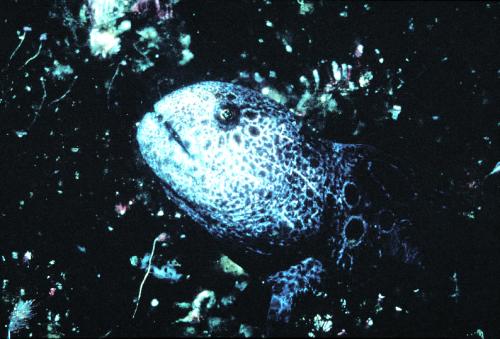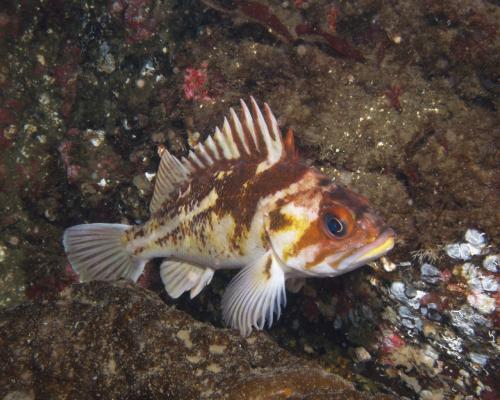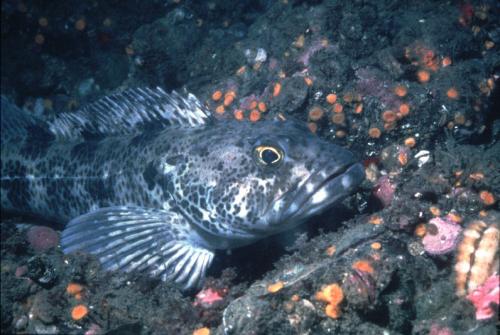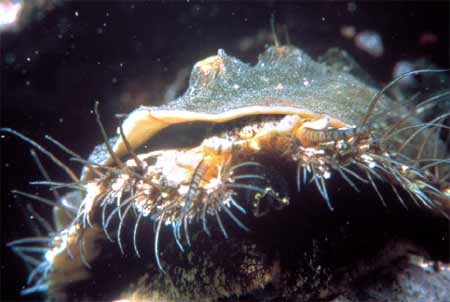Rocky reefs around the Strait provide critical habitat that supports a rich diversity of marine life, including fish, invertebrates and other animals. These include:
 More than 40 species of sculpins, ranging from tiny tidepool sculpins to the Cabezon, which grows to 30 pounds. Sculpins rely on body colours and patterns for camouflage.
More than 40 species of sculpins, ranging from tiny tidepool sculpins to the Cabezon, which grows to 30 pounds. Sculpins rely on body colours and patterns for camouflage.
 Wolf eels — fierce looking predators that can grow up to eight feet long. Divers can often hand-feed them like pets.
Wolf eels — fierce looking predators that can grow up to eight feet long. Divers can often hand-feed them like pets.
 Over 60 species of rockfish, in depths ranging from three feet all the way down to 900 feet. Rockfish are solitary and territorial. They’re also known as “scorpionfish” because their spines carry a venom that can cause pain and swelling. Photo by Terrance J. Fidler
Over 60 species of rockfish, in depths ranging from three feet all the way down to 900 feet. Rockfish are solitary and territorial. They’re also known as “scorpionfish” because their spines carry a venom that can cause pain and swelling. Photo by Terrance J. Fidler
 Lingcod, reaching 25 pounds (male) and 100 pounds (female). Fishing pressures over the years have led to low lingcod stocks in the Strait of Georgia – the lingcod population is only about 10% the size of a century ago.
Lingcod, reaching 25 pounds (male) and 100 pounds (female). Fishing pressures over the years have led to low lingcod stocks in the Strait of Georgia – the lingcod population is only about 10% the size of a century ago.
 The Giant Pacific Octopus. The world’s largest octopus species, it can weigh up to 600 pounds and have an arm spread of 30 feet. It lives on a diet of crabs, snails and other shellfish that it cracks open with a parrot-like beak.
The Giant Pacific Octopus. The world’s largest octopus species, it can weigh up to 600 pounds and have an arm spread of 30 feet. It lives on a diet of crabs, snails and other shellfish that it cracks open with a parrot-like beak.
 Abalone. This was a traditional food of First Nations people on our coast, who gathered it from intertidal areas. In more recent times, commercial and recreational abalone harvesting became much more intense. Today there are very few abalone left along our coast, and harvesting them is strictly off limits.
Abalone. This was a traditional food of First Nations people on our coast, who gathered it from intertidal areas. In more recent times, commercial and recreational abalone harvesting became much more intense. Today there are very few abalone left along our coast, and harvesting them is strictly off limits.

Bull kelp forests provide habitat for many small fishes and invertebrates. Bull kelp attaches to the bottom by a holdfast, growing up to the surface of the water with a tubular stem that be up to 80 feet long. A gas-filled bulb holds the blades afloat, allowing the plant to get the sunlight it needs to grow.
 Harbour seals use shallow reefs as haul-outs spots. At high tide seals are busy fishing, but at low tide, you’ll find them sun-bathing on tiny islets all around the Strait. Don’t get too close if you’re boating or kayaking!
Harbour seals use shallow reefs as haul-outs spots. At high tide seals are busy fishing, but at low tide, you’ll find them sun-bathing on tiny islets all around the Strait. Don’t get too close if you’re boating or kayaking!
